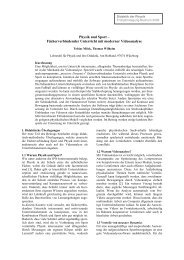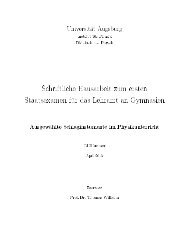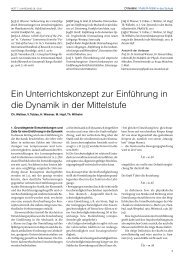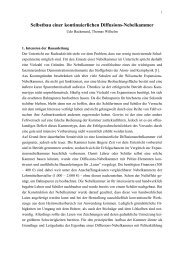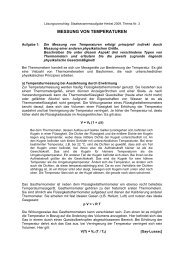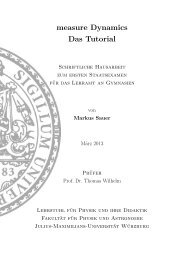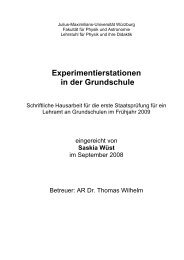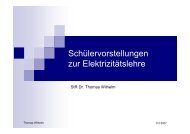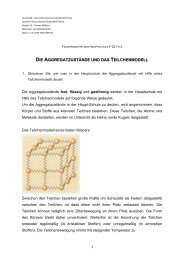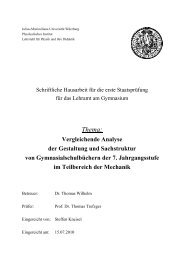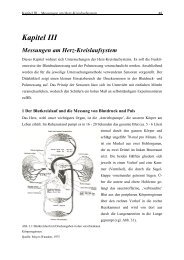- Seite 1 und 2:
Nanotechnologie im Schulunterricht
- Seite 5:
There’s Plenty of Room at the Bot
- Seite 10 und 11:
I Das Rastertunnelmikroskop 25 4 Al
- Seite 12 und 13:
9.2 Attraktive Wechselwirkungen . .
- Seite 15 und 16:
Einleitung 1 Nach dem Aufkommen der
- Seite 17 und 18:
2.1 Was ist Nanotechnologie? Allgem
- Seite 19 und 20:
2.1 Was ist Nanotechnologie? Größ
- Seite 21 und 22:
spricht man von einem top-down Verf
- Seite 23 und 24:
Nanotechnologie für den Unterricht
- Seite 25 und 26:
Inhalt Die Nanobox enthält: 3.2 Un
- Seite 27 und 28:
2. Nanowürfel - Powerspeicher der
- Seite 29 und 30:
3.2 Unterrichtsmaterialien Abb. 3.3
- Seite 31 und 32:
3.2 Unterrichtsmaterialien Beim Exp
- Seite 33 und 34:
3.3 Schulbesuche durch externe Einr
- Seite 35 und 36:
ponaten [Nanc] zu folgenden Themen
- Seite 37 und 38:
3.4 Internetangebote einzelne Schul
- Seite 39:
Teil I Das Rastertunnelmikroskop 25
- Seite 42 und 43:
„Vielleicht, daß es in der Zukun
- Seite 44 und 45:
4 Allgemeines zum Rastertunnelmikro
- Seite 46 und 47:
4 Allgemeines zum Rastertunnelmikro
- Seite 48 und 49:
4 Allgemeines zum Rastertunnelmikro
- Seite 50 und 51:
4 Allgemeines zum Rastertunnelmikro
- Seite 52 und 53:
4 Allgemeines zum Rastertunnelmikro
- Seite 54 und 55:
4 Allgemeines zum Rastertunnelmikro
- Seite 56 und 57:
4 Allgemeines zum Rastertunnelmikro
- Seite 58 und 59:
4 Allgemeines zum Rastertunnelmikro
- Seite 60 und 61:
4 Allgemeines zum Rastertunnelmikro
- Seite 62 und 63:
4 Allgemeines zum Rastertunnelmikro
- Seite 64 und 65:
4 Allgemeines zum Rastertunnelmikro
- Seite 66 und 67:
4 Allgemeines zum Rastertunnelmikro
- Seite 68 und 69:
4 Allgemeines zum Rastertunnelmikro
- Seite 70 und 71:
4 Allgemeines zum Rastertunnelmikro
- Seite 72 und 73:
4 Allgemeines zum Rastertunnelmikro
- Seite 74 und 75:
4 Allgemeines zum Rastertunnelmikro
- Seite 76 und 77:
4 Allgemeines zum Rastertunnelmikro
- Seite 78 und 79:
4 Allgemeines zum Rastertunnelmikro
- Seite 80 und 81:
4 Allgemeines zum Rastertunnelmikro
- Seite 82 und 83:
4 Allgemeines zum Rastertunnelmikro
- Seite 84 und 85:
4 Allgemeines zum Rastertunnelmikro
- Seite 86 und 87:
5 Spitzenpräparation Abb. 5.1: Ras
- Seite 88 und 89:
6 Verwendung des vorhandenen RTM 6.
- Seite 90 und 91:
6 Verwendung des vorhandenen RTM 76
- Seite 92 und 93:
6 Verwendung des vorhandenen RTM wi
- Seite 94 und 95:
6 Verwendung des vorhandenen RTM Ab
- Seite 96 und 97:
6 Verwendung des vorhandenen RTM 82
- Seite 98 und 99:
7 Ferienakademie des Piezokristalls
- Seite 100 und 101:
7 Ferienakademie 86
- Seite 103 und 104:
Ferrofluide, Magnetismus und Curie-
- Seite 105 und 106:
8.2 Magnetismus Abb. 8.1: Erklärun
- Seite 107 und 108:
8.4 Hysterese Abb. 8.2: Ausrichtung
- Seite 109 und 110:
8.5 Sonderstellung von Ferrofluiden
- Seite 111 und 112:
8.7 Rosensweig Instabilitäten In A
- Seite 113 und 114:
8.8 Modellvorstellung zum Magnetism
- Seite 115 und 116:
Physikalische Anforderungen an ein
- Seite 117 und 118:
Eth > Epot 9.1 Bedingungen an die P
- Seite 119 und 120:
9.2 Attraktive Wechselwirkungen Ema
- Seite 121 und 122:
9.2 Attraktive Wechselwirkungen A i
- Seite 123 und 124:
9.3 Repulsive Wechselwirkungen geei
- Seite 125 und 126:
9.3 Repulsive Wechselwirkungen mit
- Seite 127 und 128:
Herstellungsmethoden von Ferrofluid
- Seite 129 und 130:
10.3 Niederschlagsmethode in der Gr
- Seite 131 und 132:
10.4 Eigene Herstellungsversuche Wa
- Seite 133 und 134:
10.4 Eigene Herstellungsversuche zu
- Seite 135 und 136:
10.4 Eigene Herstellungsversuche Ab
- Seite 137 und 138:
10.4 Eigene Herstellungsversuche Mi
- Seite 139 und 140:
Anwendungsbereiche von Ferrofluiden
- Seite 141 und 142:
11.3 Anwendungen im medizinischen B
- Seite 143 und 144:
weiter an und es bildeten sich Meta
- Seite 145 und 146:
Vorteile des Einsatzes von Nanopart
- Seite 147 und 148: Ferrofluide im Schulunterricht 12 I
- Seite 149 und 150: 12.2 Mögliche Schulversuche 12.2 M
- Seite 151 und 152: 12.2 Mögliche Schulversuche dem Be
- Seite 153 und 154: N S 12.3 Versuche mit Ferrofluiden
- Seite 155 und 156: 12.3 Versuche mit Ferrofluiden Wahl
- Seite 157 und 158: 12.3 Versuche mit Ferrofluiden (a)
- Seite 159 und 160: Schlussbemerkung 13 Aus den vorange
- Seite 161 und 162: LITERATURVERZEICHNIS Literaturverze
- Seite 163 und 164: Springer Verlag, Berlin, Heidelberg
- Seite 165 und 166: Scanning, 10:128-138, 1988. LITERAT
- Seite 167 und 168: LITERATURVERZEICHNIS [Pap65] Papell
- Seite 169 und 170: Danksagung 14 Zum Abschluss dieser
- Seite 171 und 172: Selbstständigkeitserklärung 15 Hi
- Seite 173: Teil III Anhang 159
- Seite 176 und 177: A Das Rastertunnelmikroskop 162
- Seite 178 und 179: A Das Rastertunnelmikroskop 164
- Seite 180 und 181: A Das Rastertunnelmikroskop 166
- Seite 182 und 183: A Das Rastertunnelmikroskop 168
- Seite 184 und 185: A Das Rastertunnelmikroskop 170
- Seite 186 und 187: A Das Rastertunnelmikroskop 172
- Seite 188 und 189: A Das Rastertunnelmikroskop 174
- Seite 190 und 191: A Das Rastertunnelmikroskop 176
- Seite 192 und 193: A Das Rastertunnelmikroskop 178 Lag
- Seite 194 und 195: A Das Rastertunnelmikroskop 180 1 W
- Seite 196 und 197: A Das Rastertunnelmikroskop 182 Ver
- Seite 200 und 201: B Ferrofluid 186
- Seite 202 und 203: B Ferrofluid ist dieses Fluid nicht
- Seite 204 und 205: B Ferrofluid nentmagneten gestellt,
- Seite 206 und 207: B Ferrofluid zu verursachen. Nach e
- Seite 208 und 209: B Ferrofluid 194 Versuchnummer Meng
- Seite 210 und 211: B Ferrofluid wasserlöslich ist. Be
- Seite 212 und 213: B Ferrofluid All diese Kritierien w
- Seite 214 und 215: B Ferrofluid Die Konzentration der
- Seite 216 und 217: B Ferrofluid Temperatur der magneti




